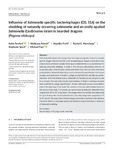Influence of Salmonella specific bacteriophages (O1; S16) on the shedding of naturally occurring Salmonella and an orally applied Salmonella Eastbourne strain in bearded dragons (Pogona vitticeps)
Renfert, Kevin
Rabsch, Wolfgang
Fruth, Angelika
Marschang, Rachel E.
Speck, Stephanie
Pees, Michael
This study determined the passage time and phage propagation time of salmonella specific phages, Felix O1 and S16, in 10 bearded dragons, based on re‐isolation from cloacal swabs and faecal samples following oral administration, as a possible tool for reducing salmonella shedding. In Study 1, Felix O1 was administered orally for 12 consecutive days. Over 60 days, swabs were taken from the oral cavity and cloaca and qualitative Salmonella detection as well as salmonella quantification from faecal samples were performed. In Study 2, a phage cocktail (Felix O1 and S16) was administered to half of the tested animals. Salmonella (S.) Eastbourne was also given orally to all animals. Oral and cloacal swabs were tested as in Study 1, and faecal samples were collected for phage quantification. Various Salmonella serovars were detectable at the beginning of the study. The numbers of serovars detected declined over the course of the study. S. Kisarawe was most commonly detected. Salmonella titres ranged from 102 to 107 cfu/g faeces. The phages (Felix O1 and S16) were detectable for up to 20 days after the last administration. The initial phage titres ranged from 103 to 107 pfu/ml. The study shows that the phages were able to replicate in the intestine, and were shed for a prolonged period and therefore could contribute to a reduction of Salmonella shedding.
Dateien zu dieser Publikation

